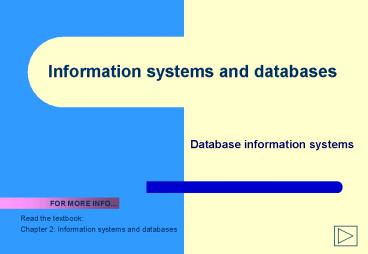Information systems and databases - PowerPoint PPT Presentation
1 / 13
Title: Information systems and databases
1
Information systems and databases
- Database information systems
FOR MORE INFO...
Read the textbook Chapter 2 Information
systems and databases
2
Flat file systems organisation
- Hierarchical schema
- Files
- Records
- Fields
- Key fields
- Characters
3
Relational databases organisation
- Logical schema
- Entities a specific category of data about
which a database needs to store data e.g.
Definitions table is an entity, Topic Area is an
entity - Attributes a property of an entity e.g. Terms
is an attribute of the Definitions table - Relationships the way in which entities in the
database are related to each other
Tables are the implementation of entities and
consist of attributes and records.
4
Views of the database
- Different views have different purposes
- Tables (entities) hold data in rows and columns
- Rows are called TUPLES
- Columns are attributes
- Forms set up for data entry
- Queries allow for questions to be asked of the
database - Reports allow for summaries and records to be
extracted from the database in various ways for
various purposes
5
Views of the database
Table view
Form view
6
Views of the Database
Query view
Report view
7
Data entry screens
- A data entry screen is one that has been designed
for a specific application. - It is usually a form.
- It may include such items on the screen as
- Drop down/List boxes for example, containing
Country - Option buttons for example, choosing Male or
Female - Dynamic update of boxes based on previous
selections for example, when you select a
customer, it only displays orders that only that
customer has placed - Buttons on the screen specific to the application
- Specific searches as required by the application
8
Reports and queries
- Every system is designed from the point of view
of information requirements what information
does the user want to get from the system? - There are two aspects of a database that produce
information Queries and Reports. - Queries questions you can ask of the database.
These need to be tailored to the specific
requirements of the user. - Reports displaying information in a presentable
and understandable format possibly with a view
to printing. - Each must be designed in conjunction with the
user and the end requirements.
9
Queries
- Query by example
- These allow criteria to be typed and a filter to
be applied to exclude unwanted data. - Query storage
- Queries can be static or dynamic. Static queries
are stored with the database and do not change.
They are used frequently. Dynamic queries are
those that have their criteria changed
frequently. Usually they are adapted from a
general query. - Complex queries
- These are queries with more than one parameter
(criteria). - Use of
- AND, OR, NOT
- For example Name is SMITH and lives in ASHFORD
10
Queries SQL
- Queries can be used to retrieve information from
a database through the use of a structured query
language (SQL). - SQL commands include
- SELECT (field or fields)
- FROM (table/s)
- WHERE (operators relational and logical)
- ORDER BY (sort)
11
Data modelling databases
- Schematic diagrams (ERD) map entity types, the
relationships between them and the
characteristics of the relationships between
entity types - Normalisation reduces data redundancy by
ensuring that each table can be edited and
manipulated separately INF and DKNF
12
Modelling data dictionaries
- A data dictionary contains descriptions of, and
other information about, the structure of the
data held in a database (metadata) - It contains information about the tables
- Minimum is fieldname, data type, size,
description. May also include keys, indexes,
joins, referential integrity etc. - It contains information about the database
itself - Permissions and users
- The data dictionary should be stored as a table
in the database. (It is usually hidden from view!)
13
DBMS
A database management system (DBMS) is a piece of
software that is used for the creation, control,
access and management of a database. The DBMS
acts as an interface between the database (raw
data) and the application programs that use the
database. Microsoft Access, Dbase and File Maker
Pro are examples of database management systems
available for microcomputers. The major function
of the DBMS is to handle access to the database,
that is, storage and retrieval of data. The DBMS
is a shell data is added to the database when
the shell has been set up.































